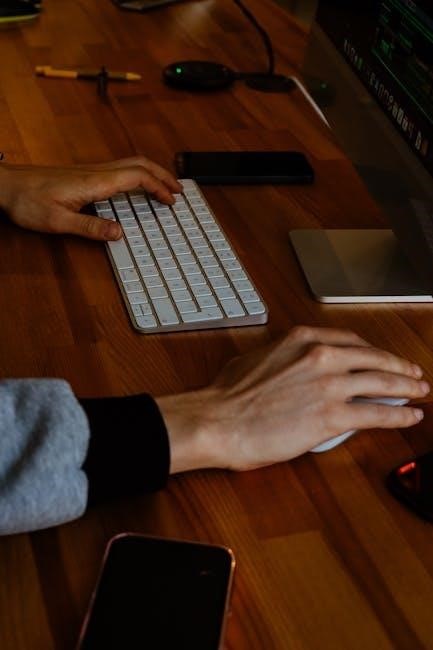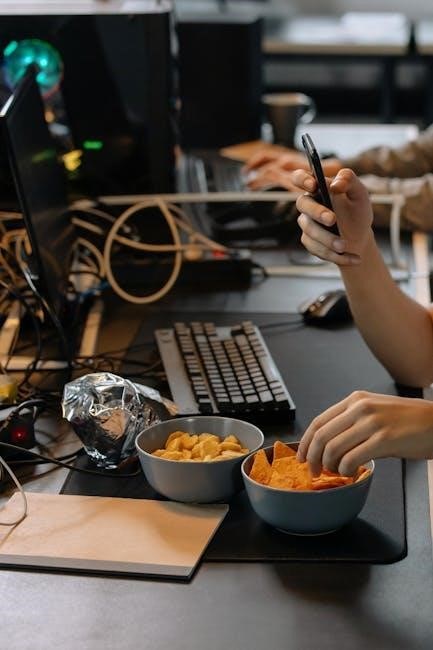The Code and Go Robot Mouse is an engaging, educational tool designed to teach kids coding skills through interactive play․ Using directional buttons and coding cards, children program the mouse to navigate mazes and reach the cheese, fostering critical thinking and problem-solving abilities in a fun, hands-on way․
Overview of the Code and Go Robot Mouse
The Code and Go Robot Mouse is a programmable toy designed to introduce children to coding concepts through interactive play․ It includes a robot mouse, coding cards, maze grids, walls, tunnels, and a cheese wedge․ Kids use directional buttons or coding cards to program the mouse to navigate mazes and reach the cheese․ This hands-on activity develops critical thinking, problem-solving, and sequencing skills․ The robot mouse is easy to use, with buttons for forward, turn, and go commands․ The activity set encourages creativity and experimentation, allowing kids to build complex mazes and customize challenges․ It’s an ideal tool for teaching foundational coding principles in a fun and engaging way, suitable for both home and classroom use․
Key Features of the Robot Mouse
The Code and Go Robot Mouse is equipped with directional buttons for programming and comes with 30 coding cards, 22 maze walls, 16 grid pieces, 10 activity cards, and 3 tunnels․ It features lights, sounds, and two speeds, enhancing engagement․ The mouse is programmable using either buttons or coding cards, allowing kids to navigate mazes and reach the cheese․ It’s designed to teach coding fundamentals, fostering critical thinking and problem-solving skills․ Suitable for both home and classroom use, the robot mouse is an interactive tool that introduces children to coding concepts without requiring a computer․ Its versatility and user-friendly design make it an ideal educational toy for developing essential skills in a fun manner․
Components Included in the Activity Set
The Code and Go Robot Mouse activity set includes a programmable robot mouse, 30 coding cards, 22 maze walls, 16 grid pieces, 10 double-sided activity cards, 3 tunnels, and a cheese wedge․ These components allow children to create custom mazes and program the mouse to navigate through them․ The robot mouse itself features directional buttons and a memory function to store commands․ Additional materials like pencils or books can be used to expand maze designs․ The set is designed to be versatile, enabling kids to experiment with different coding strategies and problem-solving techniques while having fun․ All pieces are durable and easy to clean, making the activity set suitable for repeated use in educational or home settings․

Setting Up the Robot Mouse
Start by unpacking and inspecting all components, ensuring nothing is damaged․ Assemble the maze board by connecting the 16 grid pieces into a large square․ Lay out the pieces on a flat surface and secure them to create a stable base for programming and navigation activities․
Unpacking and Inspecting the Components
Begin by carefully opening the Code and Go Robot Mouse packaging․ Inside, you’ll find the robot mouse, activity cards, coding cards, maze walls, grid pieces, tunnels, and the cheese wedge․ Inspect each component for damage and ensure all parts are included․ Place the robot mouse on a flat, stable surface, free from obstacles, to prepare for programming․ Familiarize yourself with the components, such as the directional buttons on the mouse and the grid pieces used to build mazes․ This step ensures everything is in working order and ready for assembly and programming activities․
Assembling the Maze Board
Start by connecting all 16 grid pieces to form a large square maze board․ Lay out the grid pieces on a flat surface and snap them together to create the base structure․ Follow the instructions provided to ensure proper alignment and secure connections․ Once the grid is assembled, you can begin building walls and tunnels to create a unique maze․ The maze board serves as the foundation for programming activities, allowing the robot mouse to navigate through the constructed pathways․ Ensure the board is stable and even to prevent the mouse from getting stuck or veering off course during programming sessions․
Connecting Grid Pieces
Begin by taking all 16 grid pieces from the activity set and laying them out on a flat surface․ Each grid piece connects easily to form a large square maze board․ Snap the pieces together by aligning their edges securely, ensuring a stable and even surface․ This step is crucial for creating a smooth path for the robot mouse to navigate․ Once connected, the grid provides the base structure for building mazes and programming activities․ Properly connected grid pieces ensure the mouse moves accurately and the maze remains stable during play․ This process introduces kids to the basics of construction and sequencing, making it an excellent starting point for hands-on learning․
Constructing Walls and Tunnels
Use the 22 maze walls and 3 tunnels to create obstacles and pathways for the robot mouse․ Place walls strategically to define the maze boundaries and add complexity․ Tunnels can be positioned to allow the mouse to move underneath sections of the maze, enhancing the challenge․ Ensure walls and tunnels are securely connected to the grid to maintain stability․ This step encourages kids to experiment with different layouts, fostering creativity and problem-solving skills․ By designing intricate mazes, children can test their coding sequences and observe how the mouse navigates through the constructed paths․ This hands-on activity makes learning coding concepts both engaging and interactive, preparing kids for more advanced programming tasks․
Programming the Robot Mouse
Program the robot mouse using coding cards and direction buttons․ Kids sequence commands to guide the mouse through mazes, learning fundamental coding concepts like sequencing and problem-solving․
Understanding the Direction Buttons
The robot mouse features color-coded direction buttons that simplify programming․ The green button starts the sequence, while the blue arrows (up, down, left, right) control movement․ Pressing a directional button followed by green executes the command․ Kids can test movements, observing how the mouse responds to each input․ The yellow button clears previous commands, allowing for a fresh start․ Understanding these buttons is foundational for programming the mouse effectively․ Using these buttons, children can experiment with sequences, learning how each command affects the mouse’s path․ This hands-on approach introduces basic coding concepts, encouraging logical thinking and creativity in problem-solving․
Using Coding Cards
Coding cards are a key component of the Robot Mouse activity, helping kids visualize and plan the mouse’s path․ Each card represents a specific movement or action, such as “forward,” “turn left,” or “turn right․” By arranging these cards in sequence, children create a coded path for the mouse to follow․ The process encourages logical thinking and problem-solving․ Start by laying out the cards on a flat surface, allowing kids to experiment with different combinations․ Once satisfied with the sequence, the commands can be entered into the mouse using the direction buttons․ This hands-on approach teaches cause-and-effect relationships and reinforces foundational coding concepts․ Coding cards make programming accessible and fun for young learners, fostering creativity and critical thinking skills․
Basic Operation of the Mouse
The Robot Mouse operates through a series of commands input via its directional buttons․ Kids can press the blue arrows to set movements like “forward,” “left,” or “right․” The green “go” button executes the programmed sequence, making the mouse follow the commands in order․ The mouse’s direction is determined by its facing orientation, so aligning it correctly is essential․ To clear previous commands, press and hold the yellow button, ensuring the mouse starts fresh․ This straightforward system allows children to test individual actions, observe outcomes, and refine their coding skills․ The mouse’s intuitive design makes it easy for young learners to grasp basic programming concepts through trial and error․
Executing Commands
To execute commands, press the green “go” button on the Robot Mouse․ This button triggers the sequence of programmed actions, directing the mouse through the maze․ Ensure the mouse is properly oriented before starting, as its direction is determined by its facing position․ If the mouse doesn’t reach the target, review the programmed commands and adjust as needed․ The mouse processes commands in the order they were entered, making it essential to plan sequences carefully․ Pressing the green button again resumes execution if paused․ This hands-on approach helps kids understand cause-and-effect relationships and refine their problem-solving skills through trial and error․ The mouse’s responsive design makes learning coding fundamentals both intuitive and enjoyable for young learners․
Clearing Previous Commands
To clear previous commands, press and hold the oval yellow button on the Robot Mouse until it beeps or flashes, indicating the memory is cleared․ This step ensures the mouse starts fresh with new instructions․ Forgetting to clear commands can cause the mouse to execute both old and new commands, leading to unexpected results․ Always clear the memory before programming a new sequence to avoid confusion․ This simple process helps kids understand the importance of starting with a clean slate in coding․ Regularly clearing commands also aids in troubleshooting and ensures precise execution of new programs, making the learning experience more effective and enjoyable for young coders․

Introducing Coding to Kids
Introducing coding to kids made easy with the Robot Mouse, a hands-on tool that sparks curiosity and creativity․ Using coding cards, children create sequences to guide the mouse, developing problem-solving skills and logical thinking․
Explaining the Basics of Coding
Explaining the basics of coding to kids begins with simple, relatable concepts․ The Robot Mouse introduces programming through directional buttons and coding cards, showing how sequences of commands guide the mouse․ Children learn that coding involves creating step-by-step instructions for the mouse to follow, such as moving forward, turning, or stopping․ This hands-on approach helps kids understand cause-and-effect relationships and logical thinking․ By programming the mouse to navigate mazes and reach the cheese, they see how their commands translate into actions․ This foundational knowledge builds problem-solving skills and prepares them for more complex coding concepts in the future․
Start by introducing the Robot Mouse and its components, such as the directional buttons and coding cards․ Demonstrate how to place the mouse on a flat surface and explain the function of each button․ Highlight the green “go” button, which executes the programmed commands․ Show how to input simple instructions, like moving forward or turning, and let the child observe the mouse’s response․ This hands-on approach helps children connect their actions to the mouse’s movements․ Encourage them to explore the mouse’s features, such as its speed and direction, while emphasizing the importance of sequencing commands․ This guided introduction builds curiosity and sets the stage for more complex programming tasks․
Letting Kids Explore and Experiment
Encourage children to explore the Robot Mouse and its components freely․ Allow them to experiment with the directional buttons and coding cards to understand how the mouse responds․ Let them try programming simple movements, like moving forward or turning, and observe the outcomes․ This hands-on approach fosters creativity and problem-solving skills․ Encourage kids to design their own mazes using the grid pieces, walls, and tunnels, challenging themselves to navigate the mouse through complex paths․ By experimenting with different sequences of commands, children learn cause-and-effect relationships and develop critical thinking․ This exploratory phase is essential for building confidence and sparking curiosity about coding and robotics․
Reinforcing Critical Thinking Skills
Engaging with the Robot Mouse helps children develop critical thinking skills by encouraging problem-solving and logical reasoning․ Kids learn to break down complex tasks into manageable steps, analyzing how each command affects the mouse’s movement․ Debugging incorrect sequences teaches perseverance and the value of trial and error․ Using coding cards to map out paths enhances spatial awareness and planning abilities․ As they create mazes and tunnels, children must think strategically about obstacles and shortcuts, fostering creativity and analytical thinking․ This hands-on approach to coding challenges reinforces the connection between cause and effect, helping kids build a strong foundation in problem-solving and logical reasoning․

Advanced Strategies
- Create intricate mazes using tunnels and walls to challenge navigation skills․
- Customize challenges by adding obstacles and complex pathways for advanced problem-solving․
- Incorporate problem-solving exercises that require precise command sequences for success․
Creating Complex Mazes
To create complex mazes for the Code and Go Robot Mouse, start by arranging the 16 grid pieces into a large square or rectangular board․ Use the 22 maze walls and 3 tunnels to design intricate pathways and obstacles․ Experiment with multi-level designs by stacking grid pieces or incorporating tunnels to add depth․ Introduce dead-ends and varying pathway lengths to challenge navigation․ For advanced setups, combine walls and tunnels to create hidden routes or loops․ Encourage children to think critically by designing mazes that require precise command sequences․ To increase difficulty, add moving obstacles or extra instructions, such as requiring the mouse to pass under tunnels or avoid certain paths․ This fosters problem-solving and logical reasoning while keeping the activity engaging and fun․
Using Tunnels and Obstacles
Enhance maze complexity by incorporating tunnels and obstacles to challenge the robot mouse’s navigation․ Tunnels can be placed over grid pieces to create hidden pathways, while obstacles like maze walls can block certain routes․ This forces children to think strategically about command sequences․ For example, programming the mouse to navigate under tunnels or around obstacles requires precise directional inputs․ Obstacles can also be used to redirect the mouse or create dead-ends, encouraging problem-solving․ By combining tunnels and walls, you can design multi-level pathways that test logical reasoning; These elements not only make mazes more engaging but also deepen the learning experience, teaching children how to adapt coding strategies for complex scenarios․
Customizing Challenges
Customizing challenges with the Code and Go Robot Mouse allows for endless creativity and difficulty adjustments; Users can incorporate additional materials like pencils, books, or household items to create unique maze walls․ For instance, adding extra instructions such as requiring the mouse to go under all tunnels or restricting it to only right or left turns enhances problem-solving․ These modifications make even simple mazes more complex and engaging․ Additionally, creating specific pathways or goals, such as collecting virtual items, adds layers of challenge․ By tailoring the obstacles and rules, children are encouraged to experiment with different command sequences and think critically about their coding strategies․ This customization fosters adaptability and creativity in young learners, preparing them for more advanced coding concepts․
Incorporating Problem-Solving Exercises
Incorporating problem-solving exercises with the Code and Go Robot Mouse enhances learning by challenging kids to think logically and creatively․ Activities such as navigating complex mazes, avoiding obstacles, or reaching specific targets encourage children to break problems into smaller steps․ For example, students can use coding cards to guide the mouse through a maze with tunnels, requiring precise command sequences․ Additionally, introducing constraints like limited moves or specific pathways fosters critical thinking․ These exercises help children develop sequential reasoning and adaptability, as they test and refine their codes․ By solving these challenges, kids build confidence in their problem-solving abilities and gain a stronger understanding of coding fundamentals in an engaging and interactive way․

Customization and Fun Ideas
Customize mazes using alternative materials like pencils or books, and add challenges by incorporating tunnels, obstacles, or special instructions to enhance problem-solving fun for kids creatively․
Using Alternative Materials for Mazes
Customize your mazes by using alternative materials like pencils, books, or household items to create unique walls and obstacles․ This encourages creativity and adaptability, allowing kids to experiment with different maze designs․ Instead of relying solely on the provided grid pieces, incorporate everyday objects to make the activity more engaging and dynamic․ For example, books can serve as tall barriers, while smaller items like paper rolls or toy blocks can form intricate pathways․ This approach not only enhances problem-solving skills but also teaches children to think outside the box when designing challenges for the robot mouse․ It’s a fun and cost-effective way to expand the play experience․
Adding Extra Instructions for Difficulty
To increase the challenge, introduce additional instructions that require more precise programming․ For instance, instruct the mouse to go under all tunnels or restrict it to turning only right or left․ These constraints force children to think creatively and refine their coding strategies․ You can also specify that the mouse must follow a particular sequence or avoid certain paths, enhancing problem-solving skills․ This approach helps kids understand how limitations can shape solutions and encourages them to experiment with different command combinations․ By adding these extra layers of complexity, you make the activity more engaging and intellectually stimulating for young learners․
Exploring Creative Maze Designs
Encourage creativity by experimenting with unique maze layouts and designs․ Instead of using the provided grid pieces, try constructing walls with everyday objects like books or pencils․ This approach allows children to think outside the box and visualize the maze in new ways․ You can also incorporate tunnels and obstacles to add complexity․ Varying the maze design regularly keeps the activity fresh and challenging․ By experimenting with different patterns and structures, kids develop spatial awareness and problem-solving skills․ This creative freedom fosters imagination and reinforces logical thinking, making the coding experience more dynamic and engaging for young learners of all skill levels․

Maintenance and Troubleshooting
Regularly clean the robot mouse and maze pieces to ensure smooth operation․ Check for damage and ensure all components are functioning properly to avoid performance issues․
Cleaning the Robot Mouse
To maintain the robot mouse’s functionality, regular cleaning is essential․ Turn off the mouse and gently wipe it with a soft, damp cloth to remove dirt or debris․ Avoid using harsh chemicals or abrasive materials that could damage the surface․ Dry the mouse thoroughly before turning it back on․ For tougher stains, a slightly dampened cloth with mild soap can be used, but ensure no moisture enters the internal components․ Regular cleaning prevents dust buildup and ensures smooth operation․ Additionally, wipe down maze pieces and coding cards with a damp cloth to keep them clean and functional․ This simple maintenance routine helps extend the lifespan of the robot mouse and its components․
Ensuring Proper Functionality
To ensure the Code and Go Robot Mouse operates correctly, always place it on a flat, stable surface free from obstacles․ Check that all buttons and sensors are clean and unobstructed, as dirt or debris can interfere with functionality․ Before programming, press and hold the yellow oval button to clear any previous commands, ensuring the mouse starts with a clean slate․ Verify that the mouse is facing the correct direction before executing commands․ If the mouse fails to respond, restart it or check for loose connections․ Regularly testing the mouse with simple commands, like moving forward or turning, helps confirm its functionality․ For optimal performance, avoid exposing the mouse to excessive moisture or extreme temperatures․ By following these steps, you can ensure the robot mouse functions smoothly during coding activities․
Troubleshooting Common Issues
Common issues with the Code and Go Robot Mouse can often be resolved with simple steps․ If the mouse doesn’t move, ensure all previous commands are cleared using the yellow button․ Check that the mouse is properly placed on the grid and facing the correct direction․ If the mouse moves incorrectly, verify that the coding cards are used in the right sequence and that the green “go” button is pressed after programming․ For sensor issues, clean the mouse’s sensors with a soft cloth․ If the mouse still malfunctions, restart it or ensure all components are assembled correctly․ Regularly cleaning the grid pieces and mouse ensures smooth operation․ Addressing these issues quickly helps maintain a seamless coding experience․
The Code and Go Robot Mouse is a fantastic tool for teaching coding skills, fostering creativity, and developing problem-solving abilities in children․ It encourages hands-on learning and exploration․
Final Tips for Successful Programming
Start with simple commands and gradually introduce complexity as confidence grows․ Always press the green button to execute commands․ Remember to clear previous commands using the yellow button to avoid confusion․ Encourage children to test their sequences and observe the mouse’s movements․ If the mouse doesn’t respond as expected, check for obstacles or programming errors․ Use the coding cards to map out sequences visually before inputting them․ Celebrate successes and view mistakes as learning opportunities․ For advanced challenges, incorporate tunnels and obstacles to create intricate mazes․ Provide additional resources like video tutorials or activity guides for further guidance․ Most importantly, let kids explore and enjoy the process of coding and problem-solving!
Encouraging Continued Exploration
Encourage children to experiment with new maze designs and coding sequences, fostering creativity and curiosity․ Allow them to take ownership of their learning by designing challenges for others․ Discuss how coding relates to real-world problem-solving, sparking interest in STEM fields․ Praise their efforts and celebrate their progress, no matter the outcome․ Provide opportunities for collaborative play, where kids can share ideas and strategies․ Rotate between guided activities and free play to keep the experience fresh and engaging․ Remind them that mistakes are part of the learning process and can often lead to new discoveries․ By nurturing their interest and confidence, you’ll help them develop a lifelong love for learning and innovation․
Additional Resources for Further Learning
For deeper exploration, the Code and Go Robot Mouse Activity Manual offers a comprehensive guide with step-by-step instructions and activity ideas․ YouTube tutorials, such as the one by Learning Resources, provide visual demonstrations for setup and programming․ The official Learning Resources website features additional resources, including teaching guides and troubleshooting tips․ Community forums and educator groups share creative maze ideas and lesson plans․ Encourage children to explore STEM concepts further through online coding games and robotics kits․ These resources help extend learning and keep kids engaged with coding and problem-solving activities․
